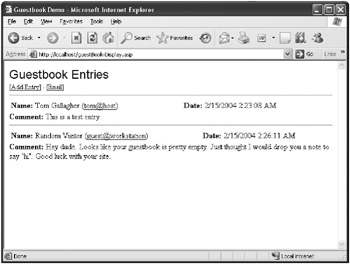Understanding Persistent XSS Attacks Against Servers
In reflected XSS attacks, the attacker s data (script) is not stored on the server; it is merely echoed by a request that contains the attacker-supplied script. Persistent XSS, sometimes called script injection , is almost identical in functionality to reflected XSS attacks except that the attacker-supplied script is stored on the server. Instead of coercing the victim into making a request that contains the malicious form data (script), the attacker can make the request that contains the script. Then, the attacker simply needs to get the victim to visit a URL that will display the script that is stored on the server.
Example: Persistent XSS in a Web Guestbook
In this section, we discuss an example of a persistent XSS attack in a Web guestbook, which is a feature that is potentially susceptible to script injection attacks. Use your browser to load the guestbook sample (guestBook-Display.asp) included on the book s companion Web site. A Web guestbook usually accepts a user s name , e-mail address, and any message the user wants to add to the guestbook. This information is stored on the server, usually in a database or file. When someone views the guestbook, the information that is stored on the server is returned to the user on a Web page. This is precisely how the sample guestbook file works, including functionality that allows the user to view everyone s submissions to the guestbook, as shown in Figure 10-5.

Figure 10-5: Entries included in the guestbook
| Note | Use the sample guestbook to experiment with viewing submissions to the guestbook. The files you need are guestbook-AddEntry.asp, guestbook-AddEntry.html, guestbook-Display.asp, and guestbookEntries.html. |
Examine the HTML returned when you view the guestbook. The text that is entered in a new guestbook entry is included. Are you getting any ideas for interesting test cases for a guestbook entry? Try to put the <script> tag as the guestbook entry comment by making it <SCRIPT>alert('Hi!')</SCRIPT> . After you submit the entry, check whether the script was injected successfully by viewing the Guestbook Entries page again. You should see an alert dialog box that contains Hi! (See Figure 10-6.) This means that arbitrary script can be injected.

Figure 10-6: Script injected into a guestbook entry
Exploiting Persistent XSS Against Servers
Because the injected script is actually stored on the server, attackers don t need victims to echo attacker-supplied script through the Web server. Attackers can send the script, store it on the server, and simply let the victim view it from there. Although reflected XSS is definitely a big problem, most security-minded potential victims will not visit the malicious Web site or click links that contain suspicious-looking data. On the other hand, persistent XSS enables attackers to exploit many victims without any effort by luring users to visit a Web site that contains the script injection vulnerability. In the guestbook example, the script runs any time a user views the guestbook. Surely the guestbook owner and other curious users will want to see the guestbook entries, and in the process they will run the attacker-supplied script. If attackers want to target specific users, they can use the same techniques they use for reflected XSS attacks, such as a link to a page that contains a script injection bug or a Web page that redirects the user.
EAN: 2147483647
Pages: 156